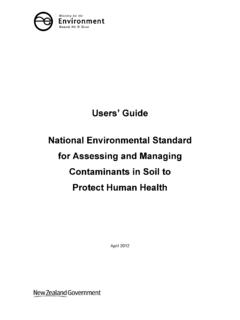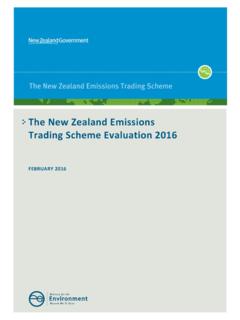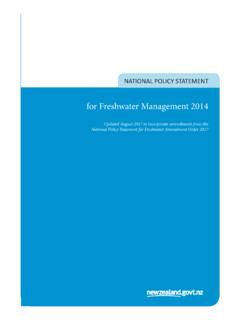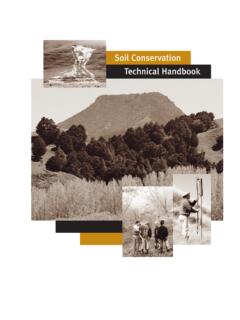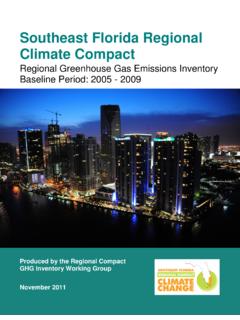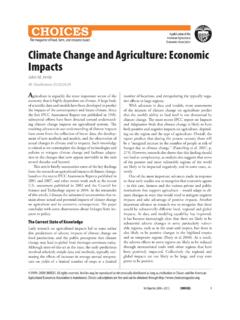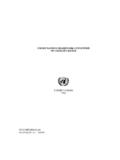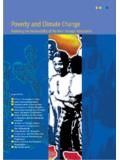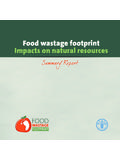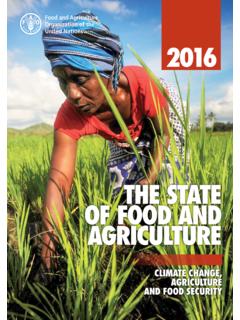Transcription of A GENERATION FROM NOW - Ministry for the …
1 A GENERATION . FROM NOW. Our long-term goals Our Mission People are enabled to make and The use of the environment, Risks to people and the Success Means implement decisions that benefit including natural resources, environment are known, society and the environment is optimised for the betterment understood and well managed of society and the economy now and over time ENABLING OPTIMISING MANAGING. a prosperous New Zealand a prosperous New Zealand a prosperous New Zealand The capacity for the environment to sustain itself is safeguarded SAFEGUARDING. a prosperous New Zealand Underlying Mana Taiao, the power and prestige of the environment is evident and provides strength to the people, Mana Tangata. Principles Mauri Taiao is the well-being and life supporting capacity of the environment, which enhances and supports Mauri Ora the health and well-being of the people. Mana and Mauri are interrelated, and one cannot be achieved without the other. Message from our Chief Executive We live in one of the most incredible places on earth, with an So, what do we want New Zealand to look like 5, 10, 30 years exceptional natural environment.
2 It's one of the things we love from now and how do we get there? Included in this booklet about living here, and it underpins our way of life our economy, is a set of outcomes that detail the long-term environmental our communities, and our culture. goals we think are worth chasing, along with intermediate targets that will help us get there. I believe these to be And we can't take it for granted. All these things depend on aspirational but also realistic. healthy and productive land, fresh air, clean and accessible lakes, rivers and seas, and the wildlife found only here in Aotearoa. These targets may change over time as our data improves . our new environmental reporting regime for example will help The Ministry for the Environment's job is to make sure our identify progress and opportunities as we go. environment supports New Zealand's prosperity economic, social and cultural without compromising it for future generations. We know we won't be able to achieve all our goals at once, and We call this environmental stewardship, and it's really important.
3 More importantly, we won't be able to achieve them alone. Being a good steward means we need to take a long-term view, I am looking forward to working with our many partners on because typically the full implications of the choices we make areas of mutual concern where together we can make the only become clear generations later. You can see this today biggest impact. serious erosion on the east coast of the North Island is a legacy of European settlement, when large tracts of bush were converted Ko te taiao he taonga tukuiho mo apopo. Our environment is to pasture. In Canterbury, the effects of development a hundred a treasured gift that we inherit for the benefit of tomorrow. years ago are still working their way through the waterways. In the same way, the choices we make today will impact on the state of our environment, and the quality of life enjoyed by New Zealanders, decades from now. Vicky Robertson Chief Executive, Ministry for the Environment New Zealand's Air Atmosphere - and climate environment today Angi -h Ko auhau We enjoy good air quality in Key findings from most places most of the time.
4 And a - hua o Air quality problems can occur, - rangi ng a Environment Aotearoa 2015 usually in winter in specific locations. Our climate shapes and supports our environment, economy, and way of life, but it is slowly changing. Airborne particles down 8% UV light high rates of since 2006, leading to improved melanoma due to UV exposure air quality Carbon dioxide concentrations 58% human-made airborne over New Zealand have particles in 2013 were from increased 21% since 1972. burning wood and coal for home heating Temperature increased over the past 100 years Carbon monoxide emissions from transport have fallen 46%. since 2001 Global greenhouse gas emissions up 33% since 1990. 2. Fresh water Land Marine Wai Whenua Wai Tai Fresh water is poorer in Our land has undergone dramatic Our marine environment urban and agricultural change since people arrived is diverse, but changes are areas, and very good in 700 800 years ago, affecting our affecting our native seabirds national parks, native bush, biodiversity and land productivity.
5 And marine mammals. and tussock. Where we want to be a GENERATION Nitrogen on land increased 29% 49% of land was used for 35% of our native seabirds from since 1990, from livestock and farming and forestry in 2012 are threatened with extinction fertiliser 192 million tonnes of eroded 27% of our marine mammals Nitrogen in rivers up 12% since soil enters our waterways each are threatened with extinction 1989, increasing the likelihood of year, affecting productivity and slime and weeds water quality Coastal sea levels and acidity are rising Water clarity has improved 14% More than 94% of New Zealand since 1989 is affected by possums, rats, and stoats Overfishing has declined since 2009. - Air Angi Long-term outcomes Long-term targets The capacity of the Adverse impacts Our vision is that New Zealand is a environment to sustain of air pollution on itself is safeguarded environmental health world leader in managing risks to are minimised human health and the environment Risks to people and the environment are Health impacts from poor air quality that result from poor air quality.
6 Known, understood and well managed are minimised 4. Intermediate outcomes Intermediate targets Threats to environmental 2020: All potential threats to environmental health are identified and a framework to identify at-risk locations health are below is implemented threshold concentrations in priority locations 2030: All at-risk locations have targeted interventions in place New Zealanders include air 2020: A cross-agency central government framework is in place for managing indoor air quality quality and thermal efficiency when making decisions about 2020: Health impacts from anthropogenic (human-made) sources are reduced by 10% from 2012 levels home heating 2025: The majority of people understand the sources and effects of poor air quality Pollutants of concern 2025: Priority barriers to meeting guideline values are identified and interventions are developed to human health are managed within identified 2030: New Zealanders reduce harmful emissions to air and improve the thermal efficiency of their homes guideline values Atmosphere and climate Long-term outcomes Long-term targets - hauhau and a Ko - hua o ng a - rangi The capacity of the New Zealand is environment to sustain carbon neutral by itself is safeguarded 2050, contributing Our vision is that New Zealand has an to global efforts to reduce emissions innovative and productive economy, with fewer greenhouse gas emissions, The use of the A carbon neutral and is resilient to the physical and environment, including natural resources, New Zealand enables a more innovative and is optimised for the productive economy economic impacts of climate change betterment of society and the economy, and adverse climatic events.
7 Now and over time Risks to people and New Zealanders the environment are effectively manage known, understood the physical and and well managed economic impacts of climate change 6. Intermediate outcomes Intermediate targets New Zealand's net greenhouse 2025: The vehicle fleet will comprise upwards of 250,000 (approximately 8%) of electric vehicles (including gas emissions peak and begin plug-in hybrids). to decline 2030: More than half of our primary energy supply is from renewable sources Hydrofluorocarbons are phased out in New Zealand 2035: New Zealand has reduced imports of hydrofluorocarbons by 85% below 2015 levels 2040: Net forest area has increased by 500,000 ha from 2015 levels Greenhouse gas emissions 2020: Solutions are in place to target all emissions not responsive to a price on carbon are reduced through effective policies and pricing 2020: There is a durable mechanism and effective pricing for greenhouse gas emissions Greenhouse gas emissions 2030: New Zealand's greenhouse gas emissions intensity (per unit of GDP) is half of what it was in 1990.
8 Are decoupled from economic growth, providing opportunity and innovation Climate change is included 2025: Businesses factor climate change into decision-making, future proofing investment and in risk management and identifying opportunities investment decisions 2025: All local authorities factor in and respond to projections of climate change impacts in their decisions, plans and investments Fresh water Wai Long-term outcomes Long-term targets The capacity of the Freshwater Our vision is that New Zealand increases environment to sustain ecosystems are itself is safeguarded healthy and resilient the value from, and improves the quality to pressures of, our fresh water. The use of the New Zealand gets environment, including best value from natural resources, freshwater resources is optimised for the betterment of society and the economy, now and over time Risks to people and Harmful health the environment are impacts from people's known, understood contact with fresh and well managed water are eliminated 8.
9 Intermediate outcomes Intermediate targets We understand water 2020: The majority of priority sites have targets and clean-up plans in place quality trends, and options for improvement in all water 2020: We have good data about the drivers, pressures, state and impact of water quality, and its accessible bodies that don't meet to the public regional objectives 2030: All water bodies have water quality and quantity limits set Water quality in priority water 2030: 100% of priority sites have clean-up plans in place and are on track bodies is measurably improved Management systems 2020: Robust timely and accessible data is available for managing water maximise the benefits of water use 2025: Tools are in place for tracking efficiency and productivity of water use 2025: A framework is in place for water users to apply good management practices for fresh water 2025: All regions have effective systems in place for iwi/hap participation 2030: The community are active participants in the management of their freshwater bodies New Zealanders know with 2025: Comprehensive regional systems are in place to monitor those contaminants that affect the suitability of confidence the safety of rivers water bodies for recreation and food gathering and lakes for recreation and food gathering 2030: New Zealanders know how safe all water bodies are for recreation and food gathering Land Whenua Long-term outcomes Long-term targets The capacity of the Soils and terrestrial Our vision is that New Zealand environment to sustain ecosystems are itself is safeguarded healthy and resilient improves the quality of our soils and to pressures terrestrial ecosystems and increases the value from our land-based resources.
10 The use of the New Zealand gets best environment, including value from land-based natural resources, resources is optimised for the betterment of society and the economy, now and over time 10. Intermediate outcomes Intermediate targets Human-induced causes of soil 2020: All hazardous substances align with global classification requirements to support international trade loss and negative impacts on soil health are addressed 2020: The compliance and enforcement of environmental controls for hazardous substances improves from a 2016 baseline Threats to environmental health are known and managed 2020: The use of substitute substances with reduced human and environmental impact are incentivised The impacts of hazardous 2020: Measures are agreed for soil health and soil loss. Baselines are established and effects of use are understood substances on the environment are understood 2020: Key indicators and baseline conditions are in place for monitoring the health of soils and terrestrial ecosystems and reduced and the impact of new organisms 2030: Interventions are in place to improve biodiversity and manage threats to ecosystem health 2030: All hazardous substances have been reviewed to ensure they provide a net benefit to society 2030: Comprehensive targeted interventions are in place to improve soil health and reduce overall soil loss Use and management 2020: National measures of land capability and natural capital are available to decision-makers decisions enhance the well-being of current 2020: Innovation and use of new organisms that contribute positively to the economy and society are encouraged and future generations and facilitated 2020.

